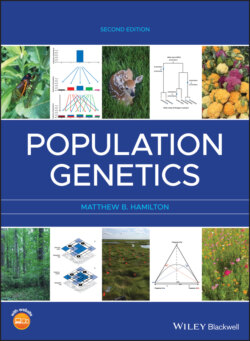Читать книгу Population Genetics - Matthew B. Hamilton - Страница 28
Testing Hardy–Weinberg expected genotype frequencies
ОглавлениеA common use of Hardy–Weinberg expectations is to test for deviations from its null model. Populations with genotype frequencies that do not fit Hardy–Weinberg expectations are evidence that one or more of the evolutionary processes embodied in the assumptions of Hardy–Weinberg are acting to determine genotype frequencies. Our null hypothesis is that genotype frequencies meet Hardy–Weinberg expectations within some degree of estimation error. Genotype frequencies that are not close to Hardy–Weinberg expectations allow us to reject this null hypothesis. The processes in the list of assumptions then become possible alternative hypotheses to explain observed genotype frequencies. In this section, we will work through a hypothesis test for Hardy–Weinberg equilibrium.
The first example uses observed genotypes for the MN blood group, a single locus in humans that has two alleles (Table 2.4). First, we need to estimate the frequency of the M allele, using the notation that the estimated frequency of M is and the frequency of N is . Note that the “hat” superscripts indicate that these are allele frequency estimates (see Chapter 1). The total number of alleles is 2N given a sample of N diploid individuals. We can then count up all of the alleles of one type to estimate the frequency of that allele.
(2.5)
(2.6)
Since , we can estimate the frequency of the N allele by subtraction as .
Using these allele frequencies allows calculation of the Hardy–Weinberg expected genotype frequency and number of individuals with each genotype, as shown in Table 2.4. In Table 2.4, we can see that the match between the observed and expected is not perfect, but we need some method to ask whether the difference is actually large enough to conclude that Hardy–Weinberg equilibrium does not hold in the sample of 1066 genotypes. Remember that any allele frequency estimate could differ slightly from the true parameter (p) due to chance events as well as due to random sampling in the group of genotypes used to estimate the allele frequencies. Asking whether genotypes are in Hardy–Weinberg proportions is actually the same as asking whether a coin is “fair.” With a fair coin, we expect one‐half heads and one‐half tails if we flip it a large number of times. But even with a fair coin, we can get something other than exactly 50 : 50 even if the sample size is large. We would consider a coin fair if in 1000 flips it produced 510 heads and 490 tails. However, the hypothesis that a coin is fair would be in doubt if we observed 250 heads and 750 tails given that we expect 500 of each.
